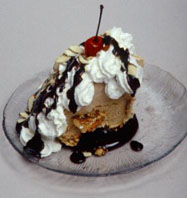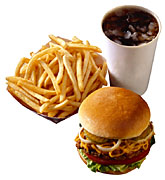|
Click here for the printable (Word) version of the lesson
Group
6: Fats, Oils and Sweets
 These are nutrients that should
be eaten sparingly - not too much each day! Some fats,
oils, and sweets are added to foods before eating, such as salad
dressing, mayonnaise, margarine and butter and table sugar.
Because you add these yourself, it is easier to eat less by not
adding them to your food or adding them in small amounts.
However, there are hidden fats and sugars in many foods.
It is important to read Nutrition Facts labels and know where
to look for hidden fats and sugars. These are nutrients that should
be eaten sparingly - not too much each day! Some fats,
oils, and sweets are added to foods before eating, such as salad
dressing, mayonnaise, margarine and butter and table sugar.
Because you add these yourself, it is easier to eat less by not
adding them to your food or adding them in small amounts.
However, there are hidden fats and sugars in many foods.
It is important to read Nutrition Facts labels and know where
to look for hidden fats and sugars.
Fats and Oils
A small amount of fat is important for health, but most of
us eat too much fat. Eating too much fat is a risk factor
of heart disease and certain kinds of cancer. Eating too
much fat can lead to obesity. Being overweight can lead
to high blood pressure and is a risk factor of diabetes.
You should limit your overall fat intake to 30 percent of your
calories and saturated fats to less than 10 percent. If
you need about 2000 calories a day, your total fat intake can
be about 65 grams of fat, with 20 grams of this amount being
saturated fat. You can learn to read labels to figure out
the grams of fat in foods you eat.
To lower your fat intake, learn to recognize foods and ingredients
that are high in fat and beware of foods with a lot of hidden
fat.
|
High-Fat
Foods |
Foods
High in Hidden Fats |
|
Butter/margarine
Shortening/lard
Vegetable oils
Cream/sour cream
Whole milk
Ice cream
Cheese
Bacon
Mayonnaise
Visible fats on meats
Gravy
Cream sauces |
Most fast-food meals
Potato chips
Regular popcorn
Fried foods
Pastries, doughnuts
Brownies, most cookies
Peanut butter
Peanuts, pecans, other nuts
Chocolate candy
Avocados and olives
Hot dogs, sausage, lunch meat
Frozen pot pies |
Easy ways to Lower Fat
- Bake or broil instead of fry.
- Choose low-fat or skim milk and other low-fat or non-fat
dairy products.
- Choose lean meats, poultry and fish.
- Trim off all visible fat and remove skin from poultry before
eating.
- Chill soups, broths and gravies and remove hardened fat.
- Get most of your calories from whole-grain and enriched breads
and cereals, rice, pasta, dried beans and peas, fruits and vegetables.
- Choose margarines that have liquid oil listed as the first
ingredient.
- Limit your intake of hidden fats.
- Change your recipes - decrease fat by at least one-half.
- Substitute applesauce for shortening in baking.
Sugars
Sucrose is the type of sugar found in table sugar, raw sugar
(unrefined sugar), powdered sugar and brown sugar (table sugar
colored with molasses). Other forms of sugar include honey,
molasses, corn syrup or high-fructose syrup. Sugars supply
calories, but little else nutritionally.
Many processed foods contain sugar. Look at the list
of ingredients on the label. Ingredients are listed in
order by weight - from greatest to least. Look for the
words that end in ose such as sucrose, fructose, dextrose,
maltose, lactose and glucose. Also, many foods contain
corn syrup and liquid sugar. If one of these sugars is
listed as one of the first three ingredients, or if several sugars
are listed on the label, the product is probably high in sugar.
The average American eats a little over 40 pounds of sugar
and sweets per year, not counting soft drinks. Sugar consumption
per person has increased almost 1 pound per year each year since
1985.
Complex carbohydrates should be the biggest part of our diet.
The best sources of complex carbohydrates are starchy foods such
as breads, potatoes, rice and spaghetti. These foods provide
other important nutrients in addition to carbohydrates.
Sugars and sweets provide carbohydrates and fill you up without
providing essential vitamins, minerals, protein and fiber.
Sweets should be used for special treats, not as a major source
of carbohydrates.
Sugar Myths
 1. Sugar Causes Hyperactivity 1. Sugar Causes Hyperactivity
Research has proved that this isn't true, although many people
believe it to be true. If a child is overexcited, it may
be due to the situation (a birthday party, being out of school
or a holiday such as Halloween) and not because of the sweets
that go along with it.
2. Sugar Causes Diabetes
This isn't true either! A person get diabetes because
of their genetics (if a relative had it), being overweight, or
age, but not because of sugar intake. When a person has
diabetes, their body can't use sugar properly. These people
must maintain a well- balanced diet that includes some sugar
but many other nutrients to keep their bodies healthy.
Sample Food Guide Pyramid Menu Plan
Breakfast
1 fruit - 3/4 cup orange juice
1 bread, 1 milk - 1 ounce cereal with 1 cup milk
1 bread, 1/2 meat - 1 slice whole-wheat toast with 2 tablespoons
peanut butter
Morning
Snack
1/2 milk, 1 bread - 1 slice cheese and 4 crackers
1 fruit - 3/4 cup apple juice
Lunch
1 meat, 2 breads, 1 fat - hamburger
1 vegetable, 1 fat - tossed salad with light dressing
1 milk - 1 cup low-fat or skim milk
Afternoon
Snack
1 fruit - banana
1 bread - 4 vanilla wafers
Dinner
1 meat - 1 piece stewed chicken
2 breads - 1 cup rice
1 bread - 1 slice bread or cornbread
1 fat - 1 teaspoon margarine
1 vegetable - 1 cup cooked greens
1 vegetable - 1/2 cup carrot sticks
Night
Snack
1/2 milk - 3/4 cup frozen low-fat chocolate yogurt
Total Food Group Servings:
Bread, cereal, rice, pasta - 9 servings
Vegetable - 4 servings
Fruit - 3 servings
Meat - 21/2 servings
Milk - 3 servings
Fat - 3 servings
Eating On The Go
 There's no great harm in eating
foods that are high in fat, sugar or sodium and low in nutrients
once in a while. Many foods eaten on the go, however, are
in that category. It's not uncommon for as many as half
of the day's diet to be foods eaten on the go. Look for
foods that offer moderate-to high levels of vitamins, minerals
or fiber. To do this, try to find foods that will help
you meet the Food Guide Pyramid's recommended number of servings
from the five food groups. Look for foods that are moderate-
to- low in fat, sugar and sodium. Here are some tips to
help you make better on-the-go choices: There's no great harm in eating
foods that are high in fat, sugar or sodium and low in nutrients
once in a while. Many foods eaten on the go, however, are
in that category. It's not uncommon for as many as half
of the day's diet to be foods eaten on the go. Look for
foods that offer moderate-to high levels of vitamins, minerals
or fiber. To do this, try to find foods that will help
you meet the Food Guide Pyramid's recommended number of servings
from the five food groups. Look for foods that are moderate-
to- low in fat, sugar and sodium. Here are some tips to
help you make better on-the-go choices:
Look in the refrigerator cases for juices, low-fat milk and
yogurt.
Substitute pretzels for chips.
Buy easy-open cans of tuna or sardines instead of Vienna sausage
or potted meat.
Choose fruit or raisins when you can.
Sometimes, get plain biscuits or a loaf of bread and some
jelly, instead of sausage biscuits, doughnuts or fried pies.
Read the labels! Look for grams of fat and milligrams
of sodium. Remember that if you take in about 2000 calories
a day, you should take in only 65 grams of fat, total.
About 2400 milligrams of sodium a day would be about the right
limit, if you're not on a low- sodium diet. Cups of soup
or meal items to microwave are often high in sodium (800-1000
milligrams).
Order a salad when available and ask for lettuce and tomato
on a sandwich.
Summary
There are six food groups in the pyramid:
- Breads/cereal/rice/pasta
- Vegetables
- Fruits
- Milk/yogurt/ cheese
- Meat/poultry/fish/eggs/beans/nuts
- Fats/oils/sweets
No one food group is more important than another. There
are no good foods or bad foods. However, it is important
to balance the high- fat or high sugar foods with low- fat or
low sugar foods over a period of one or two days
   [ LESSONS || SITE
MAP || LOCAL AGENTS || RESOURCES || PEOPLE ]
[ LESSONS || SITE
MAP || LOCAL AGENTS || RESOURCES || PEOPLE ]
Issued in furtherance of Cooperative Extension
work, Acts of Congress of May 8 and June 30, 1914, in cooperation
with the United States Department of Agriculture. The Louisiana
Cooperative Extension Service provides equal opportunities in
programs and employment. Information and Graphics on this site
are copyright protected by LSU Agricultural Center's Louisiana Cooperative Extension Services.
For more information
on the EFNEP program, contact EFNEPMail@agcenter.lsu.edu.
|